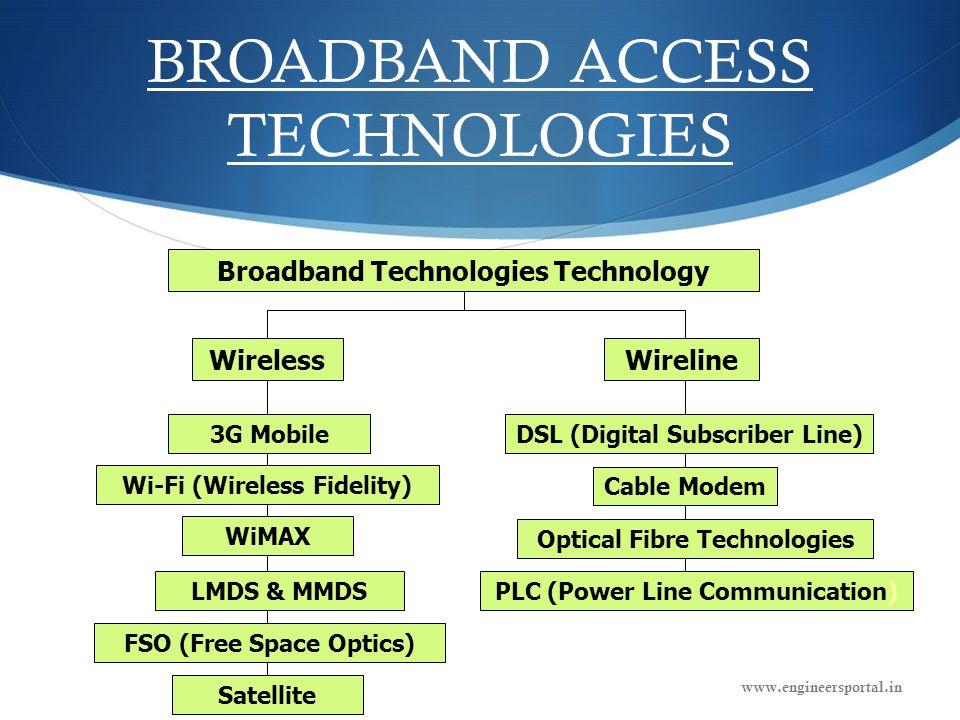Copperwireaccesstechnology
CopperwirebroadbandaccesstechnologyisalsoDSLtechnology,mainlyincludinghighbitratesubscriberdigitalloop(HDSL),asymmetricsubscriberdigitalloop(ADSL)andVeryHighBitRateSubscriberDigitalLoop(VDSL).Thetraditionalcopperwireaccesstechnologyusesmodemdial-uptoachieveuseraccessatarateof56kbit/s(digitallineaccessonthecommunicationside),butthisrateisfarfrommeetingtheuser'sdemandforbroadbandservices.Althoughthetransmissionbandwidthofcopperwiresisverylimited,becausethetelephonenetworkisverypopularnow,telephonewiresaccountformorethan90%ofsubscriberlinesintheworld.Makingfulluseofthesepreciousresourcesrequiresadvancedmodulationandcodingtechniques.
Theall-copperaccessnetworkusestimecompressionmultiplexing(TCM)andechocancellationtechnologyonthetwistedpairtoincreasethetransmissionrate.However,whenthetransmissionrateincreasestoT1(1554kbit/s)andE1(2048kbit/s),crosstalkandinter-symbolinterferenceincreaserapidly.Inordertoimprovecommunicationquality,asymmetricsubscriberline(ADSL)andultra-high-speeddigitalsubscriberline(VDSL)areused.
(1)ADSLsubscriberline
In1989,BellcoreoftheUnitedStatesfirstproposedADSLtechnology.WhenitisdifficulttoimplementFTTH,ADSLtakesintoaccounttheasymmetryofuplinkanddownlinkbandwidthwhentransmittingvideosignalsandmultimediasignalsonsubscriberlines.TheTIEresearchgroupoftheAmericanNationalStandardsInstitute(ANSI)formulatedthefirstADSLstandard(ieT1.413),anditssimplexdownlinkmaximumtransmissionrateis6.144Mbit/s.Chinaregardstherateof8.192Mbit/sasthehighesttransmissionrateofADSL.
TheuserspectrumallocationofADSLontwistedpairisasfollows:0~4kHzfrequencybandtransmitsvoicebasebandsignaltorealizetelephoneservice;20~120kHzfrequencybandisusedtotransmituplinkanddownlinklow-speeddataorcontrolinformation,andcontrolinformationrateAt16~64kbit/s;thebandwidthofthehighfrequencyband(124~1000kHz)isusedtotransmitdownlinkhigh-speeddata;thelatestADSL2+expandsthefrequencybandto2.208MHz.
(2)Ultra-high-speeddigitalsubscriberline(VDSL)
AnotherdigitalsubscriberlinetechnologyisVDSL,whichisakindof55Mbit/s,thetransmissiondistanceis0.3~1.5kmtechnology.ThechannelsofVDSLaredividedasfollows:0~4kHzisforuserstotransmittelephoneservices;4~8kHzistheuplinkchannel,usedtotransmitmediumandlow-speeddata,andtheratecanreach1.6Mbit/s;above7000kHzisthedownlinkchannel,whichtransmitshigh-speeddataservices,andthemaximumdownlinkThespeedisdividedinto3grades:12.96~13.8Mbit/sat1.5km,25.92~27.6Mbit/sat1.0km,and51.84~55.2Mbit/sat0.3km.Duetofactorssuchastechnology,theoriginalVDSLproductsusedalowerupstreamrate.
InVDSL,boththeuplinkanddownlinkchannelsuseFDM(FrequencyDivisionMultiplexing)technologyandareseparatedfromPOTSandISDNsignals.TDMA(TimeDivisionMultipleAccess)technologycanalsobeusedintheuplink.Atthistime,theuplinkchanneladoptsQPSK(QuadraturePhaseShiftKeying)modulationtechnologyorSLC(SimpleLineCoding)technologyaccordingly.
ThepurposeofVDSListotransmitmoreinformationoverashorterdistance.Therefore,VDSLusesadvancedcodingtechnologies,suchasCAP,DMT,DWMT(discretewaveletmulti-audiomodulation)andSLC,etc..Inordertoadaptthetransmissionerrorratetothecompressedvideosignal,VDSLmustadoptaforwarderrorcorrectionschemeanduseaninterleavingtechniquetocorrecterrorscausedbyimpulsenoise.
(3)ADSL2/ADSL2+
ITUcompletedADSL2(G.992.3,G.992.4)in2002,whichextendedthetransmissiondistanceandintroducedseamlessdataadaptationtechnology,Realizereal-timelinechangesandsmoothsynchronizationatbothends,supportmulti-linepairportbinding,supportintelligentmanagementandreal-timetestingandotherfunctions.Inaddition,ITUcompletedADSL2+(G.992.5)in2003.Thespectrumwidthhasbeenincreasedfrom1.1Mbit/sto2.2Mbit/s,andthedownlinkratecanreach24Mbit/swithin0.9kmand20Mbit/swithin1.2km.,Upto16Mbit/swithin1.5km.
Ingeneral,xDSLtechnologyallowsmultipleformatsofdata,voice,andvideosignalstobetransmittedfromthecentralofficetoremoteusersthroughcopperwires,andcansupportawiderangeofbusinesstypes.Itsmainadvantageisthatitcantransmithigh-speedserviceson90%oftheexistingcopperwireresourcesandsolvetheproblemthatopticalfibercannotcompletelyreplacethe"lastmile"ofcopperwire.ButDSLtechnologyalsohasitsshortcomings:theircoverageislimited(onlyhigh-speeddatatransmissioncanbeprovidedovershortdistances),andtheyaregenerallyasymmetric(usuallyhigherdownlinkbandwidth).Therefore,thesetechnologiesareonlysuitableforsomeapplicationscenariosandcanbeusedastransitionaltechnologiesforbroadbandaccess.Fromadevelopmentpointofview,variousbroadbandaccesstechnologiesbasedoncoppertwistedpairandcoaxialcablearejusttransitional.Measurescantemporarilysatisfysomeofthenewservicesthataremoredemanding,butifyouwanttotrulysolvetheaccessofbroadbandmultimediaservices,youmustintroduceopticalfibersintotheaccessnetwork.
(4)VDSL2
VDSL2isthesecondgenerationofVDSL.UnlikeVDSL,theITUhasdevelopedaVDSL2+interconnectionstandard,whichenablesVDSL2+tobecompatiblewithdifferentmanufacturers.
ComparedwithVDSL,VDSL2hasahighertransmissionrate:withinashortdistanceof300m,itcanachieveabidirectional100Mbit/sdatatransmissionrate;withinamediumdistanceof300to1500m,throughtheuseofgridCodingtechnologyandinterleavingtechnology,thetransmissionrateisalsohigherthanthefirst-generationVDSL.VDSL2hasalongertransmissiondistance.Byenhancingthetransmissionpower(20.5dBm),andwiththeuseofU0frequencybandandechosuppression,thetransmissiondistancecanreachuptoabout4.5km.VDSL2abandonstheQAMmodulationmethodandusesthesameDMTasADSL2+astheonlymodulationmethod,whichiscompatiblewithADSL2+technology.BecauseVDSL2combinestheadvantagesofADSL2+andthefirst-generationVDSLtechnology,itcanreachatransmissionrateof100Mbit/swithinashortdistance.Afteracertaindistance,itdirectlyswitchestotheADSL2+modetocontinuetoprovidemediumandlong-distancedatatransmission.ThisprovidesagoodsolutionforthetransitionfromADSL2+toVDSL2.Operatorscangraduallyupdateequipmentasneeded,whichnotonlyprotectstheoriginalinvestment,butalsoreducestheriskoftechnologyselection.
VDSL2hasperfectPSDcontrolcapabilities,usingspectrumslotting,uplinkpowerreduction(UPBO),MIBcontrolPSDandothertechnologiestocompletethepowerspectrummanagement,eliminateorreducetheimpactofinterferenceontransmissionperformance,Improvetheadaptabilitytotheaccessenvironment.Atthesametime,italsohasgoodvideoservicesupportcapabilities.Takingfullaccountofthevideoservice'ssensitivitytopacketlossorbiterrors,alotofworkhasbeendoneinimpulsenoiseprotection,dynamicchangeofinterleavingdepth,anddualdelaychannelstoreducetheprobabilityofbiterrorsandpacketlosscausedbyimpulsenoise.
Inaddition,VDSL2alsohasavarietyoftemplate(Profile)configuration,loopdiagnosisandonlinereconfiguration(OLR)andothertechnicaladvantages.
HFCtechnology
HFC(HybridFiberCoaxial,hybridfibercoaxialnetwork)referstoahybridfibercoaxialcablenetwork,usingopticalfibertotheservicearea,the"lastmile"usesthesameAxiscable.CableTVisthemosttypicalHFCnetwork.ItmakesreasonableuseofthecurrentadvancedandmaturetechnologytoprovidetraditionalanalogbroadcastTVprogramswithhigherqualityandmorechannels.However,becauseitisforthebroadcasttransmissionofanalogTVprograms,thetraditionalHFCnetworkdoesnothaveanuplinkbackhaulchannel.InordertocarryoutservicessuchasdigitalTVon-demandandhigh-frequencybroadbandaccess,theoriginalnetworkmustbetwo-wayreformed.
HFCismainlycomposedofanalogfront-end,digitalfront-end,opticalfibertransmissionnetwork,coaxialcabletransmissionnetwork,opticalnode,networkaccessunitanduserterminalequipment.
ThecommunicationofCableModemisthesameasthatofordinaryModem.Itisaprocessofinteractivetransmissionofdatasignalsonanalogchannels,buttherearealsodifferences:ThetransmissionmediumofordinaryModemisindependentbetweentheuserandtheaccessserver,thatisThetransmissionmediumisexclusivetousers,andthetransmissionmediumofCableModemisHFC,whichmodulatesthedatasignaltoacertaintransmissionbandwidthandsharesthemediumwiththecableTVsignal.Inaddition,thestructureofCableModemismorecomplexthanthatofordinaryModem./Decryptionmodule,bridge,networkinterfacecard,Ethernethub,etc.Itdoesnotrequiredial-upInternetaccess,doesnotoccupytelephonelines,andcanprovideonlineconnectionservicesatanytimearoundtheclock.
ThetechnicalrealizationofCableModemisgenerallytoseparatea6MHzchannelfrom87-860MHzTVchannels,anduse64QAMor256QAMmodulationfordownlinkdata.Theuplinkdataisgenerallytransmittedthroughafrequencyspectrumbetween5and65MHz.Inordertoeffectivelysuppresstheaccumulationofuplinknoise,QPSKmodulationisgenerallyselected.

Thefront-endequipmentCMTSuses10Base-T,100Base-TandotherinterfacestoconnecttoexternalequipmentthroughaswitchingHUB,connecttotheInternetthrougharouter,ordirectlyconnecttoalocalservertoenjoylocalservices.CableModemisauserterminaldevice,placedintheuser'shome,andconnectedtotheuser'scomputerthrough10Base-T,100Base-Tinterfaces.
ThemainadvantageofHFCisthatitprovidesnarrowband,broadbandanddigitalvideoservicesbasedontheexistingcableTVnetwork,atalowcost,andcanbeeasilyupgradedtofibertothehome(FTTH)inthefuture.Butthedisadvantageisthatitisnecessarytocarryouttwo-waytransformationoftheexistingcableTVnetworktoprovidetwo-wayservicetransmission.
Opticalaccesstechnology
(1)Broadbandpoint-to-pointactiveopticalfiberdigitalloop
Broadbandpoint-to-pointactiveopticalfiberdigitalloopsupportsDSLTheintegratedIPvoicemediagatewayfunctionisanidealplatformtopromotethebroadbandevolutionoftheaccessnetworkattheflexiblepoint(thehandoverbox).Itissuitableforthetransitionofthenetworkfromthetraditionaltelephoneterminalofficetothebroadbandnetworkcontrolledbythesoftswitch.Itissuitableforuseinuserareasoftransitionandreconstruction.TheopticaltransmissiontechnologycurrentlyadoptsEthernetopticalfiberdirectconnectionorMSTP.Adoptingthebuilt-inMSTPtechnologytoprovidecomprehensivecarryingandnetworkingcapabilitiesintheaccessnetworkequipment,aswellasunifiedmanagementcapabilities,whichisalsoaneconomicalchoice.
(2)Broadbandpoint-to-pointactiveopticalfibersystem
Thebroadbandpoint-to-pointactiveopticalfibersystemincludesbroadbandpoint-to-pointEthernettechnologyandanewgenerationofMSTPtechnology.
Broadbandpoint-to-pointactiveEthernettechnology,dedicatedlineaccessforusers,bandwidthofeachuserupto100Mbit/s,simpleofficeequipment,longtransmissiondistance,andthecostislinearwiththeactualincreaseinthenumberofusersIncrease,suitableforlow-densityareaswhereusersarescattered.Thedisadvantageisthatopticalfiberfacilitiesarededicated.Whenthedemandincreasesrapidlyandusersaredense,spacerequirementsandcostsincreaserapidly,soitisnotsuitableforhigh-densityuserareas.
ThenewgenerationofMSTPtechnologyintegratesnewfunctionssuchasVCcascade,generalframingprotocol(GFP)andlinkcapacityadjustment(LCAS),whichcanprovidebetternetworkperformanceandservicereliability,andissuitableforOpticalaccessforenterpriseusers.
Point-to-pointdirectopticalfiberconnectionhastheadvantagesofeasymanagement,nocomplicateduplinksynchronizationtechnology,andautomaticterminalidentification.Butitsdedicatedlinenetworkstructureisnotgoodforreducingnetworkcosts.Inaddition,theentireupstreambandwidthcanbeusedbyoneterminal,whichisveryconducivetobandwidthexpansion.However,itisnecessarytocomprehensivelyconsiderunfavorablefactorssuchasthecapacityofthecentralofficeequipment,theoutletdensity,andtheoccupancyofthewiringroom.
(3)Broadbandpoint-to-multipointpassiveopticalfibersystem
Inapoint-to-multipointsystem,sincetheopticaltransmitterandopticalfiberaresharedbyusers,thelinecostandcoreequipmentcostItiseffectivelyshared,andelectromagneticinterferenceandlightningeffectsofactiveequipmentareavoided,thefailurerateoflinesandexternalequipmentisreduced,thereliabilityofthesystemisimproved,andmaintenancecostsaresaved.Inaddition,thetree-branchtopologyofPONmakesitsuitableforuseasanaccesstechnologyforresidentialusers.Insuchanoccasion,deployingprotectionfunctions,especiallyfullprotectionfunctions,willleadtohigheruseraccesscosts.Therefore,unprotectedortrunkfiberprotectionisgenerallyused.
Wirelessaccesstechnology
Wirelessaccesstechnologyreferstoatechnologythatuseswirelesstransmissionmediaforacertainpartoralloftheaccessnetworktoprovideuserswithfixedandmobileaccessservices.Thecharacteristicsare:widecoverage,easyexpansion,encryption,etc.Wirelessaccesstechnologyisdividedintomobileaccesstechnologyandfixedwirelessaccesstechnology.
Mobileaccesstechnologyismainlytoprovidecommunicationservicesformobileusersandfixedusersandbetweenusers.Specificimplementationmethodsincludecellularmobilecommunicationsystems,satellitecommunicationsystems,wirelesspaging,andclusterscheduling.
Fixedwirelessaccess(FWA)technologyismainlytoprovidecommunicationservicesforuserswithfixedlocationsoruserswhoonlymoveinasmallarea.TheconnectedbackbonenetworkisPSTN.ItcanbesaidthatFWAisawirelessextensionofPSTN.ThepurposeistoprovideuserswithtransparentPSTNservices.
(1)LMDS(LocalMultipointDistributeSystem)technology
LMDSisapoint-to-multipointbroadbandfixedwirelessaccesstechnology,mainlyusingwirelessATMprotocol,andhasstandardizedequipmentinterfaceandnetworkmanagementprotocol,theworkingfrequencybandisgenerally20~40GHz,usinglarge-capacitypoint-to-multipointmicrowavetransmissiontoprovidetwo-wayvoice,data,andvideoimageservices.However,becauseitworksinmillimeterwaves,itisgreatlyaffectedbytheclimate,haspoorrainattenuationresistance,andtheworkingareaislimitedtoacertainextent.
TheLMDSsystemusuallyconsistsofabasicbackbonenetwork,basestations,userterminalequipmentandnetworkmanagement.ThebackbonenetworkcanbecomposedofATMorIPcoreswitchingplatforms,theInternet,andPSTNinterconnectmodules.Thebasestationrealizestheconversionbetweenthebackbonenetworkandthewirelesssignal,andcansupportmultiplesectorstoexpandthesystemcapacity.Generallyspeaking,userterminalshaveoutdoorunitsandindoorunits.ThemodulationmethodsthatcanbeusedintheLMDSsystemaremainlyphaseshiftkeying(PSK)andquadratureamplitudemodulation(QAM).Thewirelessduplexmodeisgenerallyfrequencydivisionduplex(FDD),andthemultipleaccessmodeisfrequencydivisionmultipleaccess(FDMA)ortimedivisionmultipleaccess(TDMA).
(2)MMDS(MultichannelMultipointDistributeSystem)technology
MMDSisafixedwirelessconnectionforserviceproviderstoprovideuserswithbroadbanddataandvoiceservices.Intotheprogram.TheworkingfrequencybandofMMDSisconcentratedin2~5GHz,andtheavailablebandwidthis2´31.5MHz(uplinkanddownlink).The3.5GHzMMDSfrequencybandhasgoodpropagationcharacteristics,andthetransmissiondistancecanreach10km.TheMMDSspectrumisnotaffectedbyrainattenuation,butcanbeattenuatedbybuildings.
MMDScanprovidepoint-to-pointconnection-orienteddataservices,point-to-multipointservices,andpoint-to-pointconnectionlessnetworkservices.ComparedwithLMDS,MMDSisnotaffectedbyrainattenuationandissuitableforoccasionswithscatteredusersandsmallcapacity.TheMMDSbasestationandnetworksideaccessincludeT1/E1,100Base-TandOC-3,andtheusersideinterfaceincludesT1/E1,10Base-T.Therefore,thebandwidthprovidedbyMMDSisrelativelylimited,andtheconstructioncostofMMDSislowerthanthatofLMDS.
(3)Wirelesslocalareanetwork
Generallyspeaking,anycomputerlocalareanetworkthatuseswirelesstransmissionmediacanbecalledawirelesslocalareanetwork.Thewirelessmediumherecanberadiowaves,infraredraysorlasers.ThebasisofthewirelessLANisthetraditionalwiredLAN,whichisthewirelessexpansionandreplacementofthewiredLAN.ItisbasedonwiredLANthroughwirelessHUB,wirelessaccessnode(AP),wirelessbridge,wirelessnetworkcardandotherequipmenttorealizewirelesscommunication.
Thenetworkingmodeofwirelesslocalareanetworkincludestwomodes:centeredandnon-centered.Whenthecenteredmodeisadopted,theaccesspointAPperformscentralizedmanagementofthewirelesschannel.Whenthecenterlessmodeisadopted,eachmobileterminalrandomlyaccessesthechannelinadistributedmanner.
Wirelesslocalareanetworkprovidesawayformobileterminalstoaccessthewideareanetwork,andmultiplemobileterminalscanalsofreelynetworkandshareresources.Itmainlysupportsthetransmissionofdataservices,aswellasthetransmissionofvoiceandimageservices.
Themainadvantageofwirelesslocalareanetworkislowinvestment.Mobileterminalscanbedynamicallyandtemporarilynetworkedtosupportroamingofmobileterminals.Thedisadvantageisthatthecoverageislimited,thebandwidthisrelativelysmall,andtherearepotentialsecurityrisks.
